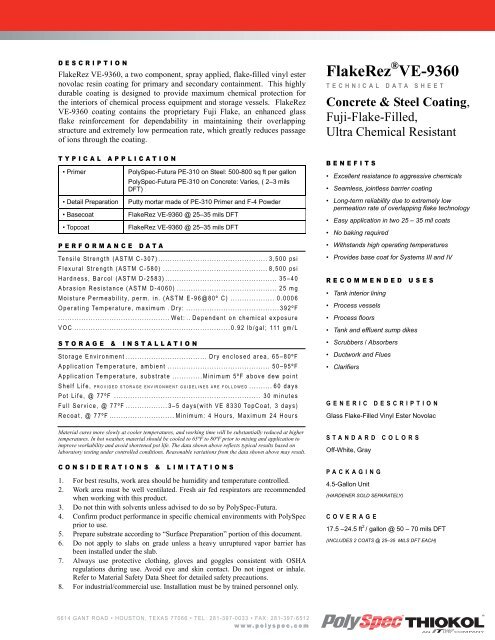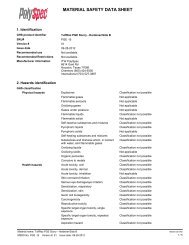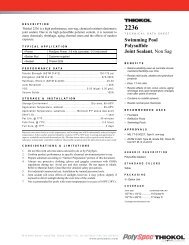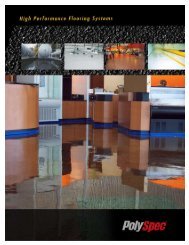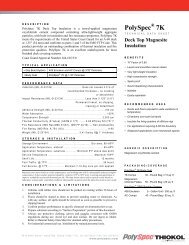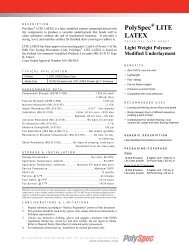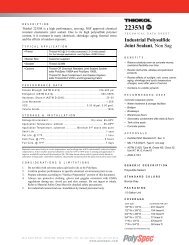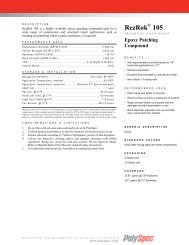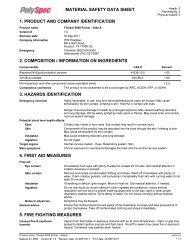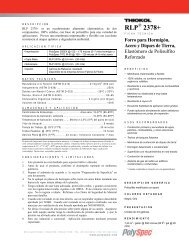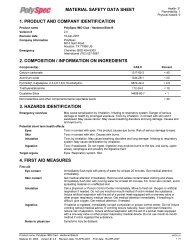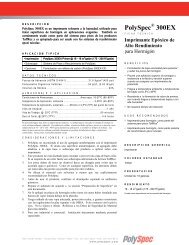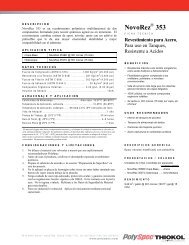You also want an ePaper? Increase the reach of your titles
YUMPU automatically turns print PDFs into web optimized ePapers that Google loves.
AND E S C R I P T I O N<strong>FlakeRez</strong> <strong>VE</strong>-<strong>9360</strong>, a two component, spray applied, flake-filled vinyl esternovolac resin coating for primary and secondary containment. This highlydurable coating is designed to provide maximum chemical protection forthe interiors of chemical process equipment and storage vessels. <strong>FlakeRez</strong><strong>VE</strong>-<strong>9360</strong> coating contains the proprietary Fuji Flake, an enhanced glassflake reinforcement for dependability in maintaining their overlappingstructure and extremely low permeation rate, which greatly reduces passageof ions through the coating.<strong>FlakeRez</strong> ® <strong>VE</strong>-<strong>9360</strong>T E C H N I C A L D A T A S H E E TConcrete & Steel Coating,Fuji-Flake-Filled,Ultra Chemical ResistantT Y P I C A L A P P L I C A T I O N• Primer• Detail Preparation• Basecoat• TopcoatP E R F O R M A N C E D A T A<strong>PolySpec</strong>-Futura PE-310 on Steel: 500-800 sq ft per gallon<strong>PolySpec</strong>-Futura PE-310 on Concrete: Varies, ( 2–3 milsDFT)Putty mortar made of PE-310 Primer and F-4 Powder<strong>FlakeRez</strong> <strong>VE</strong>-<strong>9360</strong> @ 25–35 mils DFT<strong>FlakeRez</strong> <strong>VE</strong>-<strong>9360</strong> @ 25–35 mils DFTTe n s i l e St r e n g t h ( A S T M C - 307) ............................................... 3 , 5 0 0 ps iF l e x u r a l St r e n g t h ( A S T M C - 5 8 0 ) ............................................. 8 , 5 0 0 ps iH a r d n e s s , B a r c o l ( A S T M D - 2 5 8 3 ) ................................................ 35– 40A b r a s i o n R e s i s t a n c e ( A S T M D - 4 0 6 0 ) ........................................... 2 5 m gM o i s t u r e P e r m e a b i l i t y, p e r m . i n . ( A S T M E - 96@ 8 0 º C ) ................... 0 . 0 0 06O p e r a t i n g Te m p e r a t u r e , m a x i m u m . D r y : ........................................ 392ºF................................................ W e t : .. D e p e n d e n t o n c h e m i c a l e x p o s u r eV O C ................................................................... 0 . 9 2 l b / g a l ; 111 g m / LS T O R A G E & I N S T A L L A T I ONSt o r a g e E n v i r o n m e n t ................................... D r y e n c l o s e d a r e a , 6 5 – 8 0 º FA p p l i c a t i o n Te m p e r a t u r e , a m b i e n t ............................................ 50– 9 5 º FA p p l i c a t i o n Te m p e r a t u r e , s u b s t r a t e ............. M i n i m u m 5 º F a b o v e d e w p o i n tS h e l f L i f e , P R O V I D E D S T O R A G E E N V I R O N M E N T G U I D E L I N E S A R E F O L L O W E D .......... 6 0 d a y sP o t L i f e , @ 7 7 º F ............................................................... 3 0 m i n u t e sF u l l S e r v i c e , @ 7 7 º F .................. 3 – 5 d a y s ( w i t h V E 8 3 3 0 To p C o a t , 3 d a y s )R e c o a t , @ 7 7 º F ............................ M i n i m u m : 4 H o u r s , M a x i m u m 2 4 H o u r sMaterial cures more slowly at cooler temperatures, and working time will be substantially reduced at highertemperatures. In hot weather, material should be cooled to 65ºF to 80ºF prior to mixing and application toimprove workability and avoid shortened pot life. The data shown above reflects typical results based onlaboratory testing under controlled conditions. Reasonable variations from the data shown above may result.C O N S I D E R A T I O N S & L I M I T A T I O N S1. For best results, work area should be humidity and temperature controlled.2. Work area must be well ventilated. Fresh air fed respirators are recommendedwhen working with this product.3. Do not thin with solvents unless advised to do so by <strong>PolySpec</strong>-Futura.4. Confirm product performance in specific chemical environments with <strong>PolySpec</strong>prior to use.5. Prepare substrate according to “Surface Preparation” portion of this document.6. Do not apply to slabs on grade unless a heavy unruptured vapor barrier hasbeen installed under the slab.7. Always use protective clothing, gloves and goggles consistent with OSHAregulations during use. Avoid eye and skin contact. Do not ingest or inhale.Refer to Material Safety Data Sheet for detailed safety precautions.8. For industrial/commercial use. Installation must be by trained personnel only.B E N E F I T S• Excellent resistance to aggressive chemicals• Seamless, jointless barrier coating• Long-term reliability due to extremely lowpermeation rate of overlapping flake technology• Easy application in two 25 – 35 mil coats• No baking required• Withstands high operating temperatures• Provides base coat for Systems III and IVR E C O M M E N D E D U S E S• Tank interior lining• Process vessels• Process floors• Tank and effluent sump dikes• Scrubbers / Absorbers• Ductwork and Flues• ClarifiersG E N E R I C D E S C R I P T I O NGlass Flake-Filled Vinyl Ester NovolacS T A N D A R D C O L O R SOff-White, GrayP A C K A G I N G4.5-Gallon Unit(HARDENER SOLD SEPARATELY)C O V E R A G E17.5 –24.5 ft 2 / gallon @ 50 – 70 mils DFT(INCLUDES 2 COATS @ 25–35 MILS DFT EACH)COMPANY
S U R F A C E P R E P A R A T I O NConcrete: Apply only to clean, dry andsound concrete substrates that are free of allcoatings, sealers, curing compounds, oils,greases or any other contaminants.• New concrete should be cured aminimum of 28 days.• Concrete that has been contaminatedwith chemicals or other foreign mattermust be neutralized or removed.• Remove any laitance or weak surfacelayers.• Concrete should have a minimum surfacetensile strength of at least 300 PSI perASTM D-4541.• Surface profile shall be CSP-3 to CSP-5meeting ICRI (International ConcreteRepair Institute) standard guideline#03732 for coating concrete, producinga profile equal to 60-grit sandpaper orcoarser. Prepare surface by mechanicalmeans to achieve this desired profile.• Moisture vapor transmission should be 3pounds or less per 1,000 square feet overa 24 hour time period, as confirmedthrough a calcium chloride test, as perASTM E-1907. Quantitative relativehumidity (RH) testing, ASTM F-2170,should confirm concrete RH results


